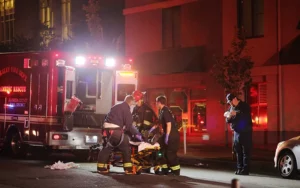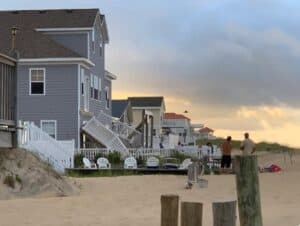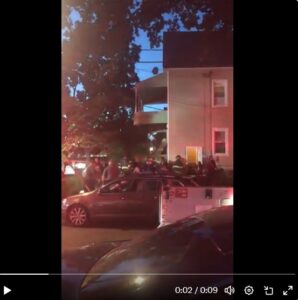On August 30, 2019, legislation was enacted that focuses on balcony safety, particularly balcony safety for common interest developments.
Senate Bill 326 (SB 326) requires associations with multifamily dwellings to conduct inspections of Exterior Elevated Elements. Exterior Elevated Elements are the collective name for common area components, such as balcony railings, decks, patios, stairways, and walkways to determine whether they are safe and in good condition.
The requirements of SB 326 are similar to SB 721, which stipulated balcony inspections for apartment buildings and multi-family projects. However, common interest developments were not included from SB 721 to ease the burden on homeowners associations.
How SB 326 Improves Balcony Safety

Senate Bill 326, informally dubbed “The Balcony Bill”, adds two new statutes to the Davis-Stirling Act: Civil Code 5551 and Civil Code 5986.
Civil Code 5551 states that associations are now required to perform balcony safety inspections for balconies and other exterior structures that the HOA is obligated to maintain.
Regular inspections help associations ensure that balconies, deck walkways, stairways, and other exterior structures are structurally sound and in compliance with building codes and regulations. Inspecting balconies helps HOAs keep items, animals, children, and residents from potentially falling through a broken railing or space.
Civil Code 5986 voids developer-friendly items in governing documents that removes or hinders an HOA’s ability to file a lawsuit against builders for construction defects.
This second statute addresses pre-litigation voting requirements for lawsuits filed by HOAs for construction defects. California Civil Code Sec. 5986(b) notes that “…governing documents shall not impose any preconditions or limitations on the board’s authority to commence and pursue any claim, civil action, arbitration, pre-litigation process”.
Balcony Safety Inspections Prevent Tragedies
Whether it’s a hung, stacked, cantilever, or high-rise balcony, safety inspections are vital to ensuring the health and safety of residents. When balconies are safe, there is less risk of children, pets, and objects falling through a space in the railings.
On the other hand, when there is no concern for safety, balconies and railings can put HOA residents at risk of injury or death.
Balcony Collapse In Berkeley, California

Caption: Image credit: David Yee via Berkeleyside
In 2016, a balcony sheared off of an apartment complex, resulting in several injuries and deaths. Lawsuits were filed against the building contractors for using composite wood, rather than pressure-treated wood, as well as allowing the balcony to be soaked by the rain before enclosing it. These early missteps caused many red flags that the owners of the apartment complex ignored, such as mushrooms growing on the exterior of the balcony.
Deck Collapse in San Francisco, California
In 2018, a woman and her husband were injured when their wooden balcony suddenly collapsed. A San Francisco city building inspector noted that the collapse likely occurred because of dry rot. The homes had been constructed in the 1940s without balconies – those were added on later.
Thankfully, this balcony collapse did not involve any deaths. However, it is still a good reminder of the importance of regular balcony inspections, whether it’s a high-rise balcony or not.
Deck Collapse In Virginia Beach, Virginia

Caption: Image Credit: Brett Hall via Wavy (10 On Your Side)
In July 2020, a deck collapsed in Virginia Beach and injured five people. The family staying in the house was visiting from Pennsylvania and was just finishing up dinner when the balcony collapsed. According to city records, the house was built in 2008 and was owned by a family in Maryland, who rented the house to vacationers.
Deck Collapse In Hartford, Connecticut
BREAKING: Witness to porch collapse in Hartford says they just brought out a baby, @NBCConnecticut pic.twitter.com/qMPSfg4kAy— Jill Konopka (@jillkonopka) July 8, 2018
In 2018, a deck collapse in Hartford, Connecticut caused injuries to 15 people, including several young children and a baby. A family party was taking place in the two-story house when the incident occurred. Right after someone had brought the baby out on the second-story porch, the porch floor collapsed and caused nearly 20 people to fall to the first floor, at ground level.
Although this incident did not result in any life-threatening injuries, it is another serious reminder to conduct regular inspections and maintenance on buildings, homes, and apartment complexes, and other properties.
Address deck and balcony repairs early!
Addressing repairs and replacements early will reduce the chances of young children, pets, or other objects falling through a space in railings. This is often why many regard a safety net as a great solution. A safety net can reduce the chances of pets, purses and other objects, and children falling and causing injury to themselves or others.
When balconies, deck railings, and stairs aren’t properly maintained, injuries and death often occur. It’s a sad thought to think that the tragedies above could have been prevented with proactive maintenance and routine safety inspections.
From the time a balcony is installed, routine inspections are critical to protect kids and pets from a fatal fall. Railings and balconies that are properly supported with a secure hold & load-bearing connection won’t be putting adults and children at risk, giving owners the peace and security that comes with prudent action.
Rather than rely on special assessments or vain hope that something won’t happen, leave room in your association budget for repairs and replacements.
Balcony Safety Inspection Requirements In SB 326
The intent behind SB 326 is to prevent the collapse of balconies as occurred in Berkeley in 2015, when six friends fell to their deaths after high-rise balcony safety was neglected.
Whether it’s repairing cracks in the asphalt or repairing a swing set, HOA maintenance is critical to preventing a tragic accident. It’s best to handle maintenance for common area components in proactive steps, not last-minute scrambles.
So what exactly does SB 326 say about inspections for high-rise balcony safety, railings, stairways, and walkways? Well, although we’re not lawyers, we’ve listed some notes and highlights from California Civil Code 5551 below:
Balcony safety inspections must be done every 9 years.
A balcony safety inspection must be completed a minimum of once every nine years. The inspection must be conducted by a licensed architect or structural engineer and include a random sample of numerous exterior structures like high-rise balcony railings, walkways, stairways, and other exterior elevated elements (EEE).
The inspection must assess whether EEE structures like balconies and railings are in a safe condition and functioning in accordance with applicable safety standards.
The 9-year limit is no random number as the statute of limitations on construction defects is 10 years. The association’s board will now have authority to pursue the builder for faulty construction. To prevent bias, developer-affiliated HOA board members will not be allowed to participate in this decision.
Safety inspectors must create, provide, and reference the list of EEE structures.
Before beginning the first inspection, safety inspectors must generate a list of the locations for all exterior elevated elements (EEE). This list must include the locations for all EEE structures, including decks, balconies, stairways, walkways, railings, their load-bearing components, and any related waterproofing systems.
Inspectors provide this list of EEE locations to the subdivision for reference during future safety inspections. Safety inspectors must perform their work using the generated list of EEE structures and locations. If an inspector notices damage or potential for damage to load-bearing components, then they may use their professional judgement to determine whether an additional inspection is necessary.
A written report must be provided with findings of visual inspection
Following a visual inspection of exterior elevated items, their load-bearing components, and associated waterproofing systems, a safety inspector must provide a written report that:
- Identifies building components, their load-bearing components, and the associated waterproofing systems.
- Assesses of the current condition of the inspected load-bearing components and waterproof systems. This section must also include whether the condition threatens HOA residents’ health and safety.
- Estimates the expected future performance and remaining useful life of the inspected load-bearing components and waterproofing systems.
- Recommends necessary repairs or replacements of unsafe or damaged load-bearing components and waterproofing systems.
- Includes the inspector’s stamp or signature
- Is presented to the HOA board and incorporated into the reserve study, pursuant to Section 5550.
Inspectors must provide copy of inspection report to code enforcement
The inspector is asked to identify if further action is necessary. After the inspection is complete, a written report is required to be turned into the local code enforcement agency giving a detailed description of the EEE’s and the findings.
After receiving the inspection report, associations must take preventive measures to prevent resident access to areas and structures identified as unsafe in the inspection report.
Our professionals are here to help you!
With the passing of this bill, all common interest developments are required to complete their first inspection prior to January 1, 2025.
At California Builder Services, we assist with public reports, perform reserve fund studies, and prepare HOA budgets. Our professionals provide accurate financial analysis for tenancy in commons, commercial subdivisions, and other types of common interest developments throughout California.








